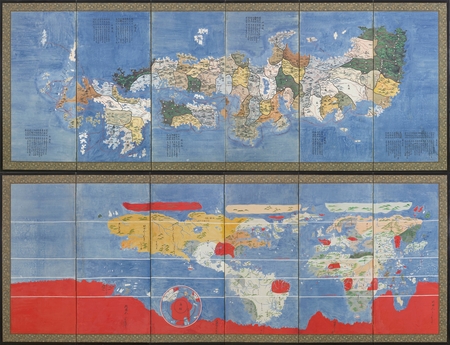Product Description
7344 A pair of six-fold namban byōbu sekaizu-nihonzu (Southern Barbarian* style screens with maps of the world and Japan) painted in ink and colour on a buff ground with geopolitical maps of Japan and the world. The right hand screen depicts a map of Japan extensively annotated with place names and listings of the provinces and their revenues. The provinces are clearly defined by borderlines and different colours, some areas showing dense forests or mountain ranges with red lines denoting the major routes both by land and water.
The left hand screen depicts a map of the world relatively accurately. Equatorial and tropical lines are marked in white and various countries are rendered in different colours.
Japan 19th century Edo period
Dimensions: H. 44″ x W. 114½” (111.5cm x 290.5cm)
Namban byōbu sekaizu-nihonzu
Map making in Japan is said to have originated with the maps drawn by a Buddhist priest Gyōki (668–749) and later maps of Japan depended largely on this original work up to and during the Edo period.
After the introduction of the compass and astrolabe by the Portuguese during the Momoyama period (1573-1615), map making became considerably more accurate. The daimyo Oda Nobunaga (1534-1582) was said to have possessed both a world globe and a world map during his attempt to unify Japan. Unification was later achieved under the leadership of Tokugawa Ieyasu (1543-1616) when he gained power in the early 1600’s. Ieyasu understood the importance of accurately recording Japan’s coastline since a great part of the economy depended on coastal marine trade and a small number of large scale maps were painted on folding screens in addition to folded paper maps and maps in books and albums. At least thirty world maps screens are known to have been created in Japan during the early modern period. They weave together cartographic information from several different European sources. This depiction of large maps on screens might have had an educational use but they would also have been considered objects of curiosity and decoration as well as conversation points.
Although earlier in date similar examples can be found in the collection of: Jōtokuji temple, Fukui Perfecture (Important Cultural Properties).
*Just as in China, Europeans came to be known as namban, or ‘southern barbarians’ based on their sailing patterns of reaching Japan from the south.










